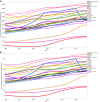Burden of polycystic ovary syndrome in the Middle East and North Africa region, 1990-2019
- PMID: 35488014
- PMCID: PMC9052181
- DOI: 10.1038/s41598-022-11006-0
Burden of polycystic ovary syndrome in the Middle East and North Africa region, 1990-2019
Abstract
Polycystic ovary syndrome (PCOS) is one of the most important contributing factors to infertility. In this study, we report the burden of PCOS by age and sociodemographic index (SDI) for the 21 countries in the Middle East and North Africa (MENA) region. Publicly available data on the point prevalence, incidence and years lived with disability (YLDs), from 1990 to 2019, were retrieved from the Global Burden of Disease (GBD) 2019 study for the 21 countries in MENA. The results are presented with age-standardised numbers and rates per 100,000 population, along with their corresponding 95% uncertainty intervals (UIs). In 2019, the age-standardised point prevalence and incidence rate for PCOS in the MENA region were 2079.7 (95% UI: 1392.0 to 2812.3) and 77.2 (95% UI: 51.6 to 105.4) per 100,000, respectively, which represents a 37.9% (95% UI: 31.7 to 45.0) and a 33.7% (95% UI: 27.7 to 40.3) increase since 1990, respectively. Also in 2019, the age-standardised YLD rate of PCOS in this region was 18.7 (95% UI: 7.8 to 37.9) per 100,000 women, which has increased by 36.1% (95% UI: 29.4 to 43.4) since 1990. Kuwait [25.4 (10.7, 51.2)] had the highest age-standardised YLD rate, while Afghanistan [10.8 (10.1, 49.2)] had the lowest. Moreover, the largest increase in the YLD rate, from 1990 to 2019, was seen in Sudan [90.3% (64.1, 120.9)], whereas no country decreased during the measurement period. The total prevalent number and point prevalence of PCOS (per 100,000) were both highest in the 20-24 age group. The prevalence of PCOS was highest among women of reproductive age, but decreased rapidly after 45 years of age. Moreover, at the country level there was a positive association between SDI and the age-standardised YLD rates of PCOS. The growing prevalence and burden of PCOS in the MENA region highlights the need to implement cost-effective preventive programs, especially for women in their third decade of life, and in MENA countries with higher SDI levels.
© 2022. The Author(s).
Conflict of interest statement
The authors declare no competing interests.
Figures





References
Publication types
MeSH terms
LinkOut - more resources
Full Text Sources
Medical
Research Materials

